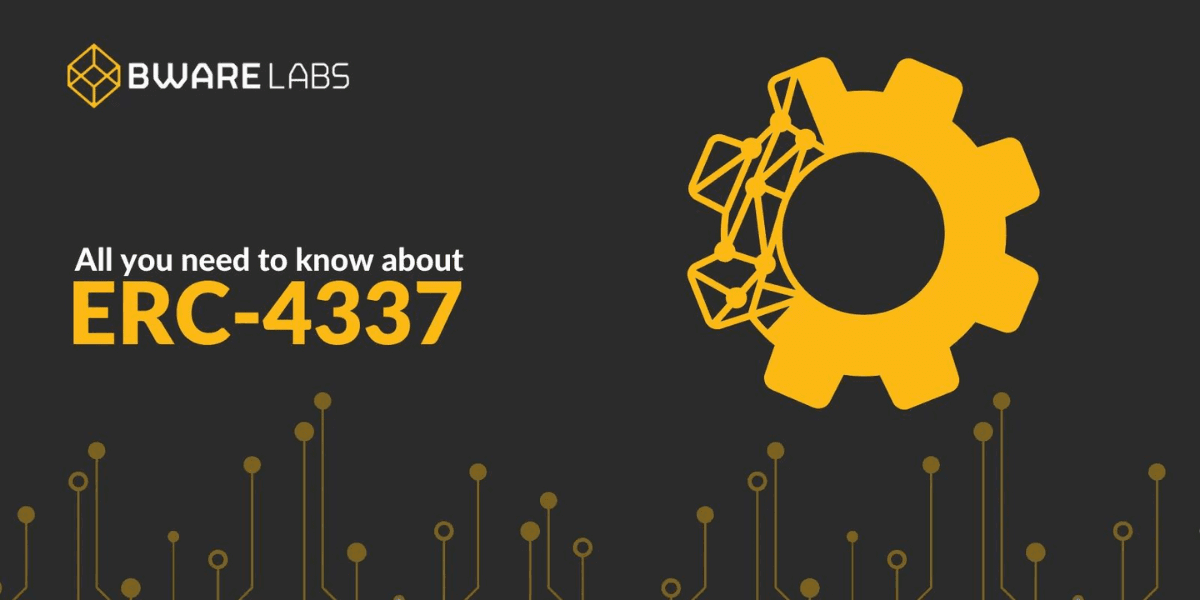
Ethereum Introduces ERC-4337 — A New Standard Geared Up to Bring Mainstream Adoption to Web3
Bware Labs Team
How can you make more people worldwide adopt blockchain technology when anything from signing transactions to building Web3 applications isn’t exactly a breeze? The answer to the question is Ethereum’s new standard ERC-4337.
Officially announced on March 1st at WalletCon in Denver, the big surprise from Ethereum promises to make the entire operation of setting up a crypto wallet effortless and user-friendly. Additionally, users can say goodbye to the fear of losing their private keys because they’ll now be able to recover them.
Yet, the benefits of ERC-4337 go beyond crypto and could positively impact all areas of the Web3 space. Read below to find out why.
What Exactly is ERC-4337
Entitled “the supercharger meant to increase Web3 adoption”, ERC-4337 is a standard that simplifies the functionality and improves the Ethereum network’s security. The new standard brings new features and permissions to the table, plus a more flexible token supply model.
Aiming to overcome the challenges of onboarding users in the crypto space, ERC-4337 introduces accessible and user-friendly smart accounts (aka account abstraction) for every crypto and Web3 enthusiast, not just tech-savvy users.
Abstraction in A Nutshell
Account abstraction is an easier way for people to use Ethereum wallets and interact with the Ethereum network.
Users will simply have to use smart contract wallets instead of externally owned accounts (EOAs) — a crypto wallet like MetaMask, for example. This will be the new way to perform transactions.
Account abstraction can also be implemented on any EVM-compatible blockchain, like BNB Smart Chain, Polygon, Avalanche, Optimism, or Arbitrum.
The way ERC-4337 works under the hood goes like this:
- once the user starts a transaction process, the standard ensures this transaction is sent on behalf of the user
- this transaction goes into a mempool — like a waiting room for unconfirmed transactions
- nodes on the Ethereum network act as a “bundler” (a block builder), packing up multiple transactions into a single one
- after the “bundling” is complete, they send it to a global “singleton” smart contract, known as the “EntryPoint”
- the transaction is validated after checking signatures and paying a fee

The Pros and Cons
The Pros
Easy wallet setup
The complicated and rather tedious process of setting up a crypto wallet is history! You can now enjoy an intuitive UX where you can open an account on your smartphone the same way you would for any app: using a fingerprint or face scan.
Improved security
Apart from removing the concept of seed phrase, ERC-4337 allows you to set up two-factor authentication for transactions and spending limits. You’ll have to store keys in a hardware security module (HSM), providing the same security levels as a self-custodial crypto wallet. You can also configure multi-signature wallets, where more users will need to sign transactions.
Recovery of private keys
So far, losing your private keys meant losing access to your wallet with zero hope of getting it back. Now, if your seed phrases are lost or stolen, you can recover your crypto assets through a time-locked recovery process; this process involves selecting a few people you can trust or a commercial service that’ll give you access back to your wallet.
Zero minting fees
As one of the main blockers that kept people from entering the blockchain world, ERC-4337 eliminates the gas fees associated with minting. NFT creators or dApp developers can allow users not to pay any gas fees for a set time period to test their creations or projects via a paymaster. This paymaster is a smart contract set up to extract gas fees only if the final decision is to buy or invest in a project.
Enabled automated payments
Like a banking app, you can set spending limits or schedule payments, like paying monthly subscriptions from your crypto wallet to any service that accepts cryptocurrency payments.

The Cons
It’s very new
The fact that it was just introduced means a significant part of the Ethereum community hasn’t started to use it. This could make developers and even Web3 newbies hesitant and only willing to try it once it gains more traction and support.
Has limited compatibility
As ERC-4337 isn’t yet compatible with other token standards, developers would be required to make several changes to their dApps, so they’re reconfigured with the new standard. This time-consuming activity could also make dApp development more complex, adding more challenges for developers.
Thus, ERC-4337 is rather more suitable for new projects.
What Does ERC-4337 Standard Mean For The Future of Web3?
To sum up the novelties that ERC-4337 standard brings, here are the key takeaways:
- crypto wallets will work as smart contracts (or smart accounts)
- smart accounts provide the same user experience as well-designed banking apps
- you can recover your private keys
- a brand can make an NFT drop completely free, and you won’t have to pay for the gas fee of the transaction
In the future, smart accounts could offer the same ease of use and security that you currently get from traditional finance. Apart from eliminating the need for seed phrases, you might enjoy something similar to the “forgot your password” system that you get nowadays for most online services.
NFT trading could become more accessible for all users, especially since ERC-4337 enables gasless transactions. Subscription services for Web3 projects could flourish and turn into what eCommerce is today.
And these are only a few examples. Since it’s bound to become one of the standards for building dApps, ERC-4337 could bring several other use cases meant to increase Web3 adoption.

